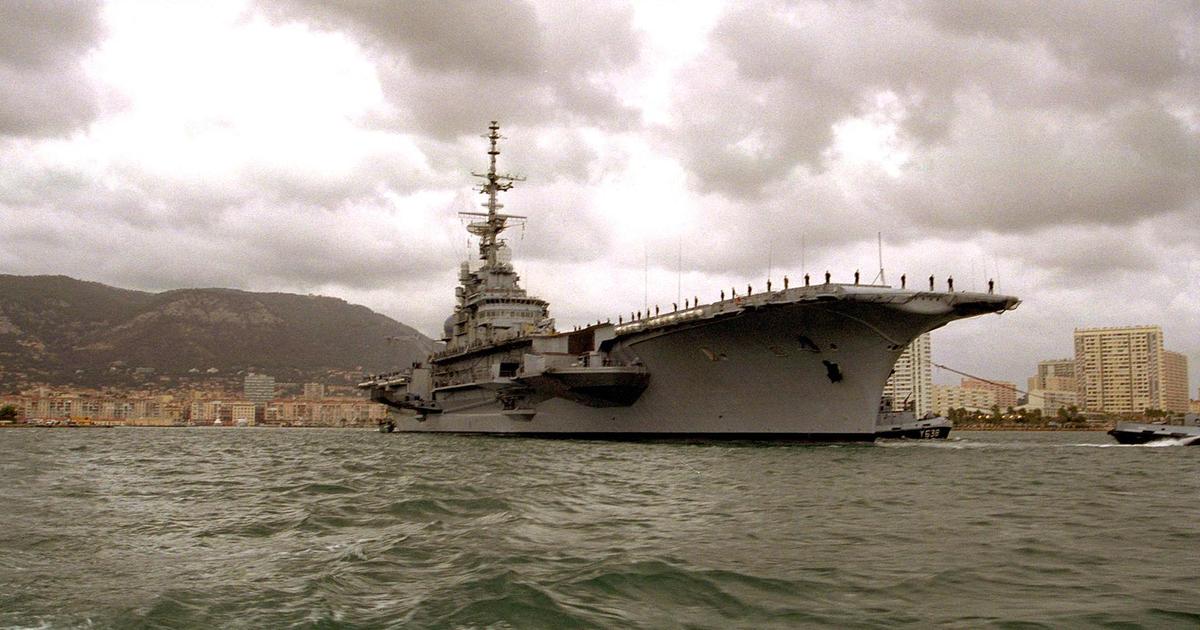Old age is a shipwreck, and the aircraft carrier Foch, former flagship of the French Navy, has not escaped it.
Encumbered by this poisoned carcass, Brazil announced on Friday February 3 that it had sunk the building in the Atlantic Ocean, filled with asbestos, paint and other toxic waste.
This decision was expected and feared by several environmental defense organizations which denounced a “
major environmental crime
”.
The
Foch
now rests nearly 350 kilometers from the Brazilian coast, at a depth of more than 5,000 meters.
The wreck is doomed to slowly decompose, crushed by the weight of the ocean and eaten away by salt water.
This fate is harsh in comparison with the aura from which the ship benefited at its peak, when it was the instrument of projection of French power in the world.
The
Foch
was designed in the mid-1950s. Arkivi / Picture Alliance / Bridgeman Images
The Foch off the Lebanese coast on September 22, 1983, with Super Étendard fighter-bombers on board.
The aircraft carrier supports French forces engaged in the civil war in Lebanon.
PHILIPPE BOUCHON / AFP
Of major strategic importance, the
Foch
was designed in the mid-1950s, as France sought to replace aircraft carriers loaned by the United States and the United Kingdom after the war.
Read alsoThe new French aircraft carrier, which will replace the Charles de Gaulle, unveils its silhouette
"
The objective was to have two modern aircraft carriers to take part in NATO missions and at the same time gain independence from the allied countries
", explains naval history specialist Philippe Querel, who also recalls that new jet planes required improved aircraft carriers.
The launch of a Rafale M01 on April 29, 1993. At the time, the State had just placed an order for the first thirteen serial Rafale combat aircraft for the Navy and the Air Force.
BORIS HORVAT / ARCHIVES / AFP
The aircraft carrier Foch with its sister ship the Clemenceau, which traveled more than a million nautical miles between 1961 and 1997. Reuters
A visit by President François Mitterrand and Prime Minister Édouard Balladur on the occasion of the 50th anniversary of the Provence landings.
Reuters
Wars in the former Yugoslavia
After the
Béarn
, a battleship transformed into an aircraft carrier in the 1930s, France therefore acquired, at the dawn of the Fifth Republic, two new aircraft carriers with a carrying capacity of around forty aircraft, more resistant bridges and more powerful catapults to implement the American Crusaders and the French Étendards.
The
Foch
participated in the nuclear tests carried out by France in the Pacific, in support missions for the French contingent in Lebanon in the Mediterranean in 1983, or even in the deployment of the French army during the wars in the former Yugoslavia, in the Adriatic.
A French army Super-Etendard lands on the aircraft carrier Foch in October 1998 as part of military exercises in the Adriatic Sea before a possible NATO air operation against Serbia to force it to withdraw its troops of Kosovo.
PASCAL GUYOT / AFP
A photo taken the same day in the Adriatic Sea.
PASCAL GUYOT / AFP
A reconnaissance Super Étendard 4P on the flight deck of the Foch, February 4, 1999 in the Adriatic Sea.
GERARD JULIEN / AFP
But over the years, diesel propulsion has proven to be less suitable than nuclear propulsion, which France already masters in its submarines.
The nuclear boiler rooms offer increased autonomy and save space in the hold: the
Foch
and the
Clemenceau
each use 800 tonnes of fuel per day and have to refuel at sea every two or three days.
The captain commanding the Foch, Anne-François de Saint-Salvy, looks at the screens of the "control tower" in May 1999. The aircraft carrier houses two Super-Frelon helicopters, on alert for CSAR missions (rescue of combat) and Super-Etendard combat aircraft armed with 250 kg laser-guided bombs.
THOMAS COEX / AFP
Technicians check the bombs intended to arm the Super-Etendard.
THOMAS COEX / AFP
A helmsman monitors the pressure gauges in the engine room.
THOMAS COEX / AFP
brazilian pavilion
The supply operation required "
an interruption of air activity for several hours as well as a supply route determined by the weather conditions at the time, which was valuable information for a potential adversary
", explains Admiral Édouard Guillaud, former Joint Chief of Staff, in a note from the Foundation for Strategic Research (FRS).
On February 1, 2001, the aircraft carrier changed flag.
EMMANUEL PAIN / AFP
The
São Paulo
leaves the military port of Brest on February 1, 2001. It is expected in Rio de Janeiro on February 17, 2001, after a stopover in Dakar, Senegal.
EMMANUEL PAIN / AFP
The São Paulo
aircraft carrier
in 2011. Brazilian Navy/Reuters
And above all, a ship is of course not eternal.
“
Unlike a car, a ship operates 24 hours a day, and wear and tear on the machinery and the structure is inevitable
,” recalls Philippe Querel.
The
Foch
was therefore withdrawn from active service in 2000, three years after the
Clemenceau
to favor a new generation.
She was then bought by Brazil for twelve million euros, and renamed
São Paulo for the occasion,
before being decommissioned for good in 2017
,
the Brazilian navy refusing the option of an overly costly modernization.
In final retirement, the aircraft carrier then began a long escheat, just like its predecessor the Clemenceau before it.
Brazil is struggling to get rid of the cumbersome wreck and ends up finding a Turkish buyer to dismantle it.
After multiple convolutions, Turkey finally refuses to recover the Foch even though it was skirting the Moroccan coast.
Shunned by all the ports, including in Brazil, the building was finally sent to the bottom by the Brazilian navy which had taken it in tow.
A satellite image from Friday February 3 before the carrier was sunk.
Greenpeace Brazil

